Blissful Bites (5 page)

I like to keep glass and stainless steel bowls of various sizes and a dough scraper by my prepping station. The scraper helps me quickly pick up chopped veggies and place them in a bowl to make room on the cutting board for the next chopping project.
Get glass (not plastic) liquid measuring cups, at least one four-cup and one two-cup; stainless steel dry measuring cups that usually come in a set; and a couple of sets of stainless steel measuring spoons.
I like to have both the stainless steel steamer basket that opens up and the bamboo kind that has many layers. Sushi mats come in handy to makeâ¦well, sushiâbut I also use them as space savers by covering a bowl with a mat, then putting another bowl on top and so on. This is great when soaking both grains and beans in separate bowls.
If your produce is organic, and I hope it is, you don't need to peel it. Just buy a vegetable scrub brush and scrub it under running water. But for the times that you do need a peeler, it's good to have a few on hand, both the usual straight kind and the Y-shaped. I find the kind you slip on one finger a bit awkward. As for graters, my favorite brand is Microplane, but the standard box variety will do just fine.
Fun tools to have in your repertoire are a Microplane zester and a citrus reamer. Adding citrus juice (e.g., lemon, lime, orange) and citrus zest is a lovely way to turn a regular recipe into something gourmet. Be sure to lightly zest the outside of the fruit, being careful not to zest into the white parts because that is bitter. You can use the zester to grate ginger as well to make ginger juice.
Â
blissful trick
Store extra citrus zest or grated ginger in a small glass jar in the freezer for up to a month so you have it available for another recipe.
A spray bottle is great to have for putting oil in to make your own pan spray, instead of buying the aerosol stuff from the store. I like the stainless steel kind as opposed to the plastic kind. Personally, I put safflower or grapeseed oil in the bottle, but you can use which ever oil you like.
In your essential baking tools stash include large stainless steel baking sheets, a loaf pan, a Bundt pan, a muffin tin, a mini-muffin tinâgo wild! Get what you think you'll need, and if those silicon types float your boat, then get them too. You can use less oil with those. Make sure you always have parchment (not waxed) paper on hand, and a sturdy rolling pin. Additionally, make sure to get a digital timer or twoâdon't trust those winding ones. A metal frosting spatula can come in handy as well. If you don't trust your oven, grab a thermometer to make sure your oven is not running too hot.
Lastly, ice cream scoopers are really handy for easy scooping, for filling muffin tins and for measuring out cookie dough.
immersion blender
An immersion blender (stick or wand blender) can come in handy when you are pureeing soup inside the pot or don't want to break out the blender. The KitchenAid set comes with a four-cup mixing beaker, wire whisk, and nut chopper attachments, all in a nifty canvas bag.
This is like a Japanese mortar and pestle that has a large bowl filled with grooves. It's used to blend things by hand and make gomasio (sesame salt) and other condiments, like the
dulse pumpkin seed condiment
, on page 168. A mortar and pestle is great for blending spices, making curry pastes, and pureeing small jobs by hand.
A flame deflector can be used under a pot to help distribute the heat evenly across the pan. It can be helpful in cooking grains so the bottom doesn't burn.
If you're interested in making pressed salads, your own pickles, or fermented foods, then grab a pickle press. These are usually a plastic container fitted with a lid that has an easy pressing knob that puts weight on whatever you're pressing. You can find presses online or at Japanese grocery stores.
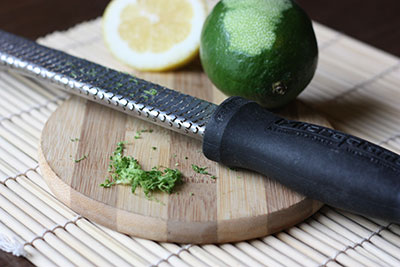
The best thing you can do to become a seasoned chef in your own kitchen is to practice, practice, practice! Take cooking classes to learn how to use a knife properly and to become skilled in various cooking techniques.
And, remember, eating simply is a good way to eat, so every meal doesn't have to be a gourmet cook-a-thon. If cooking plant-based meals seems daunting, a good way to start is to set a realistic goal for yourself each week. Learn basic cooking first, like how to make grains, cook vegetables in a tasty way, and how to make plant-based protein dishes with beans, tofu, and tempeh. Try at least two recipes out of this book per week, then go from there.
Making delicious, nourishing food can take some time, but if you plan your weekly meals and prep a few things beforehand, you'll shave several minutes off each recipe. Here are some great tips of the trade to get you started making blissful meals while saving money and time:
- On Sunday, plan your menu for the week around what is available at the farmers market and what you already have in your pantry. If you have certain grains or beans stocked, use those up before you buy more. Write your weekly menu out in a notebook while making your shopping list. I find it's better to go to the store with a list so you don't end up wandering around aimlessly.
- Choose two days a week for “batch cooking,” where you cook a large pot of grains and beans that you can use throughout the week. After all, it doesn't make sense to cook one cup of grains; you might as well make three cups, and then use it for various meals. For instance, out of one pot of brown rice you can make porridge for breakfast and sushi for lunch. Then you can use it in a grain salad for dinner, mixed into a soup for a one-pot meal, and in rice pudding for dessert. Finding crafty ways to use leftovers will not only save time and money, it will also encourage you to be creative in the kitchen.
- Get your vegetables washed, cut, and ready to go every few days. It's best if you buy veggies whole and cut them yourself. The precut veggies at the store have been cut and stored in a plastic bag for days, leaving them lifeless and tasteless. Cut your own and store them in airtight glass containers. Buy “green” bags to keep produce fresh for up to a week (as long as it hasn't been precut). These special bags can be found online or in most natural food stores and they really do work!
- Always wash grains, nuts, seeds, and beans before using in a recipe. They all have enzyme inhibitors on the outside, which prevent them from germinating too early; rinsing them washes this off. Also, if you are buying these items from the bulk bins (which I hope you are, since it reduces packaging and wasteâplus it saves you money), they'll be dirty and possibly contain small stones that need to be picked out. To wash, put the food in a medium bowl, cover with water, and swirl your hand around, moving in a circle or a figure eight pattern. Drain and do the same thing again until the water is clear. You can use a mesh strainer after the final wash to catch anything that remains.
- Some of these items will need to be not just rinsed but soaked as well. In the grain and bean section, I specify which foods need to be soaked and which can go without. For those grains and beans that need to be soaked, rinse them thoroughly first, then cover them with water in a bowl right before you go to bed. You really can't over soak grains and beans, unless you leave them soaking for days. Cook them as soon as you wake up while you get ready for your day.
- Avoid the easy “junk food” way out. Do this by planning ahead and making sure that healthful food is always available to you. Have your pantry and fridge stocked, so when you come home from work you can easily figure out what to do for dinner. Also, if you have a tendency to run for the vending machine at work, make healthy snack foods to take with you like the
chewy trail mix bars
, on page 234. If healthy food is not easily accessible, you are more likely to make poor decisions on what to eat and miss out on bliss.
you never make the same thing exactly the same
This is a funny thing about cooking. Everything you could possibly think of affects the food you make. Your mood, the weather, your environment, not to mention the quality of ingredients and where they came from, or how long they've been sitting in your pantry all affect how a recipe is going to turn out. Sometimes these things only have a small effect, but I wanted to put it out there for you to think about anyway. Another thing: If two people make the same exact recipe, the dish will come out differently for the same reasons I listed. Everyone has a different energy and personality, and that goes into the food. So your
coconut bliss granola parfait
, on page 35, is going to look and probably even taste a little different than mine, and that's okay. I want you to own that parfait, because it's made from your hands and that's pretty rad.
Go ahead and be creative. Don't feel like you have to stick to the recipe exactly. If something calls for zucchini, and you can't stand zucchini or only have broccoli, then give the broccoli a whirl or just leave it out completely. Don't feel trapped by these recipes. Recipes are building blocks or springboards that help guide you in making delicious, vibrant meals. If the recipe is a spring recipe but it's wintertime, then change the vegetables to whatever is in season at the moment and you have a whole new dish.
Both dried and fresh herbs have their place in plant-based cookingâoften in the same recipe. With dried herbs, you always want to add them to the recipe toward the beginning, either sautéed in oil or water, or blended into a sauce or dressing. Since they have been dried you must reconstitute them, which will bring out their flavor. You need more fresh herbs than dried herbs to get a concentrated flavor. For example, if a recipe calls for dried coriander, I might use a teaspoon or tablespoon. But if I wanted fresh coriander (cilantro), I would use more like one-quarter of a cup. With fresh herbs, you want to add them to the recipe toward the end or use them as a garnish.
Adding nuts and seeds to a dish or using them as a garnish is an easy way to up the flavor, presentation, and nutrients of a recipe. I always buy raw nuts and seeds, then toast them myself in a skillet (rather than in the oven, where they are more likely to burn). Over a medium flame, heat up your skillet and add the nuts or seeds. Make sure the flame is not too high. The pan doesn't need oil because the nuts already have plenty. Stir frequently or shake the pan back and forth. Try not to walk away from the pan for too long because they will burn before you know it! Keep stirring until the nuts are golden brown and fragrant. Depending on the nut and how much you chopped it (this should be done before adding them to the pan), this process could take anywhere from two to ten minutes.
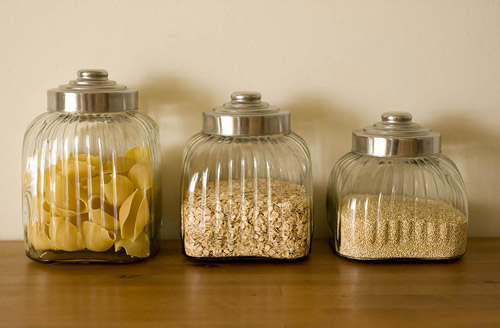
Many recipes say season with sea salt to taste. This is because everyone's taste buds are different and my preferred level of salt is going to be different than yours. You will need to season the recipe to your preference, but remember it's always best to cook the salt/seasoning into the food rather than applying salt at the dinner table. Adding salt in the cooking process brings out the natural flavor of the food, and you will end up using less salt in the long run (and we could all use a little less salt in our lives). Start with a little, and add a touch more as you go along. If you add too much at the beginning, it will be very difficult to fix the saltiness of the recipe.
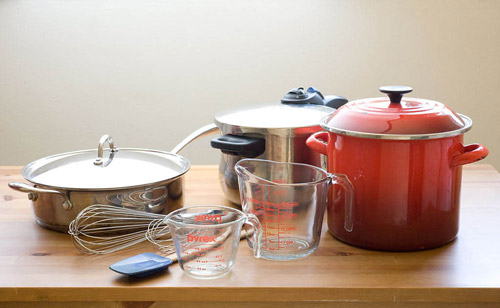
Another way I season recipes is to use shoyu, tamari, or coconut aminos. Shoyu is a high-quality, unpasteurized soy sauce made by fermenting soybeans with water, salt, and wheat. Many of the brands found at Asian markets or regular grocery stores are high in sodium and contain alcohol. Try to find a high-quality shoyu or soy sauce that does not have alcohol. Tamari is the wheat-free version and is thicker and stronger in flavor than shoyu, so you can use less. I prefer tamari because it's gluten-free. Coconut aminos is the new kid on the block; it is raw, gluten-free, and soy-free. Experiment with all of these seasonings to see which you like best.
In an ideal world we would all be born with knife skills. Learning proper knife techniques can save you time, heartache, and frustration (and fingers in many cases). If possible, take a class near you or watch videos online. But the best way to learn knife skills is to practice. So get out that fancy new chef knife and get to choppin'! Below I describe the most commonly used cutting techniques.
A chiffonade is a fine slice or shred of leafy vegetables or herbs. You would use this cut for lettuce in salads, wraps, or tacos and with fresh herbs like basil. To chiffonade, simply stack a few leaves, roll them into a cigar shape, and slice. Remember to remove any tough, woody stems that you want to exclude from your preparation.
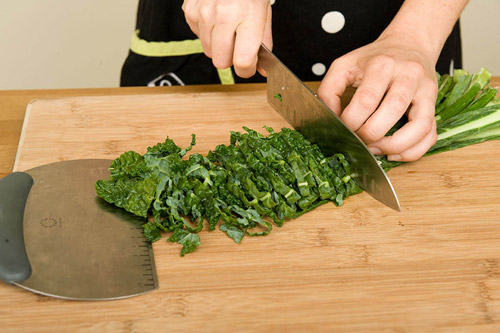
Chopping a vegetable means it can be cut into chunks that do not need a uniform or specific shape. This is most commonly used for soups, stews, or anything that gets pureed.
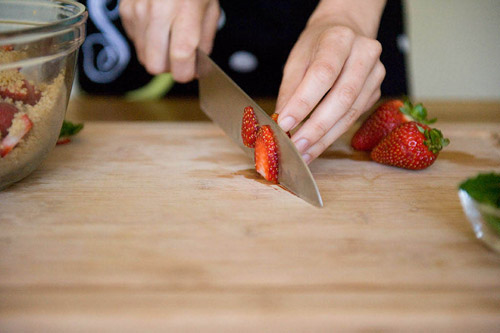
Also called a bias cut, cutting on the diagonal means you position your vegetable at a 45-degree angle on the cutting board while aiming your knife in the same direction as you cut. The angle to which you have your knife will determine how long the diagonal cut will be. I use this cut mostly for sautéed vegetables, stir-fry, and soups.
Shredding is usually done with cabbage and carrots for dishes like cole slaw, and can be done by hand or with a food processor. To shred by hand, first remove the wilting outside leaves of the cabbage. Cut it in half down the center, then cut those pieces in half again. Carefully cut out the stalk. Put the flat side down on the cutting board and straight slice down one side of the cabbage until it's all in strips.
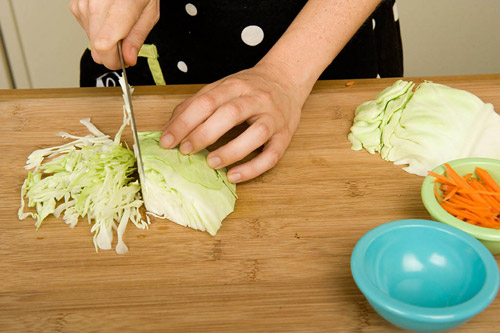
Dicing is cutting a vegetable into small cubed pieces. That usually means cutting the vegetable the long way first, then turning it to cut in the other direction. The size of your dice depends on how wide you cut these rows. You would use this cut anytime you want your vegetable in uniform pieces.
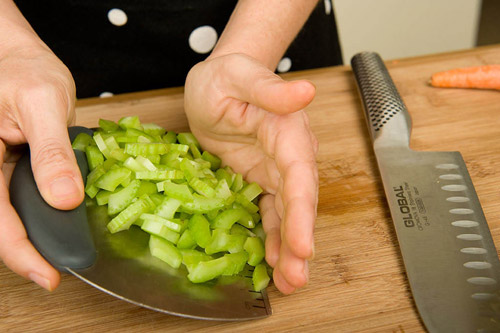
This is achieved by cutting a round vegetable like a zucchini in half lengthwise, putting the flat side down, then cutting perpendicularly down the vegetable in whatever thickness you desire. To do a quarter-moon, cut the halved piece in half again lengthwise before cutting down the vegetable. This cut is beautiful and great for any dish.
This describes the cutting of vegetables into uniform, matchstick-sized pieces. Begin by neatly cutting the vegetable on the diagonal at about 45 degrees. Next, stack one to three pieces and slice into strips longways. If some of your strips come out thicker than others, you can always go back and slice them thinner. You could use thicker matchsticks for sautés and thinner ones for raw salads.
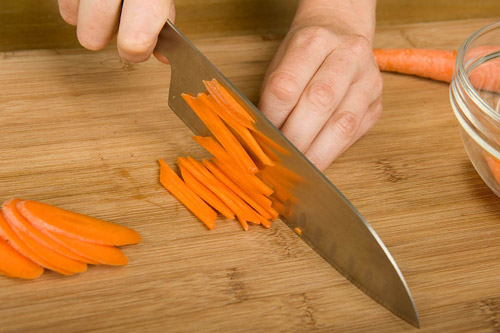
Minced food is chopped finely into tiny bits. Mince the ingredients using a rocking or chopping motion, so that the front or tip of the blade maintains contact with the cutting board, while the back of the knife moves up and down, back and forth, doing the work. Use the sides of the knife to “pile” the ingredients repeatedly, as you continue mincing into very small particles. I use this technique for herbs and ginger.
